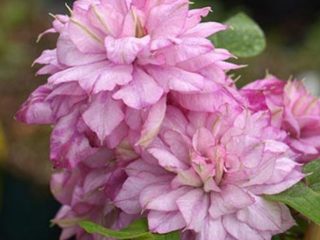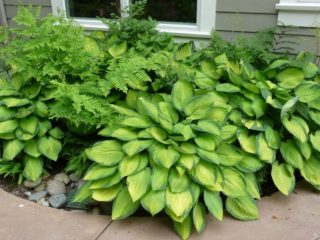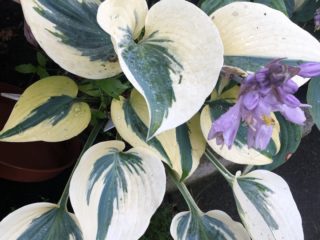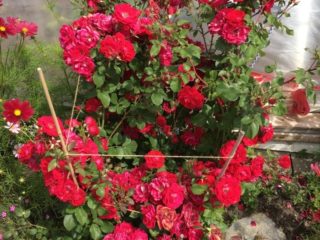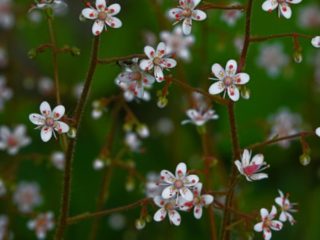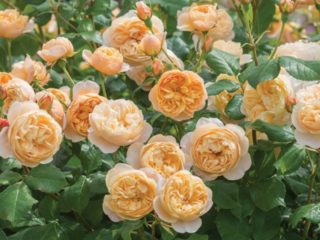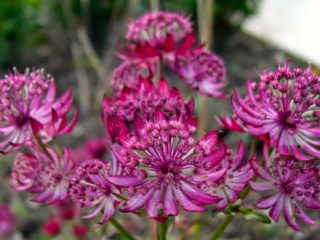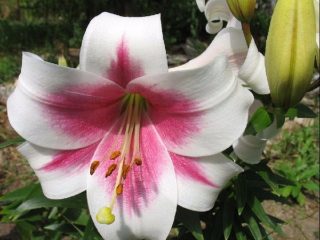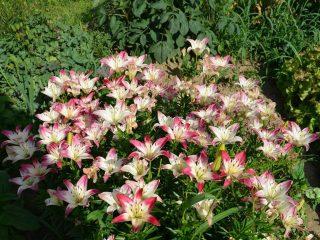Content
Rose Ballerina is a fast-growing variety that has received the best selection characteristics. The plant blooms profusely and for a long time, smells pleasant and does not require constant supervision from the owner. The last inflorescences may bloom until the arrival of autumn cold weather. Despite the simple structure of the flower, the culture is widespread in the landscape sphere.
History of variety development
The variety was obtained by German breeders in 1937. The originator was the Bentall couple. Rose Ballerina belongs to the musky hybrid varieties. She has excellent immunity to disease and long flowering.
Description of the rose Ballerina
The bush grows up to 100 cm in height, while its diameter is approximately 1.5 times larger. The plant has strong stems, thanks to which the inflorescences remain intact even in strong winds.

The thorns on the shoots of the Ballerina rose are clearly visible - they are very large and prickly, which creates some problems in care
The leaves are slightly longer than other garden roses. The variety has a rich green tint. There are teeth along the edges of the leaf blades. Rose Ballerina is grown on a trunk.Without a shaping haircut, it takes on a ball shape, perfect for decoration. With the help of bushes they decorate the veranda, porch, flower beds, paths.
Rose Ballerina is one of the few varieties with three waves of flowering:
- the first occurs in spring, it is stable and saturated;
- the second begins in June and lasts until August, characterized by less splendor;
- the third lasts from the end of August until the arrival of frost, it is characterized by moderate flowering.
First, the Ballerina rose is covered with tiny buds. They have a white color, which over time gives way to soft pink, and later again to snow-white. The stamens also change color: at the beginning of the growing season they are yellow, while towards the end they become completely brown.
By the time they open, the buds are grouped into numerous inflorescences. The flowers emit a faint but pleasant scent. Their diameter reaches 4-6 cm, but due to their group splendor, their miniature sizes do not have a significant impact on their attractiveness. After flowering, variegated fruits are formed on the peduncles, from which seeds will subsequently appear.
Advantages and disadvantages
Park rose Ballerina is a winter-hardy variety that can withstand cold temperatures down to -35 degrees. The culture grows well in light-filled meadows, in light shade.

When growing the Ballerina rose as a hedge, it is possible to protect the garden from the cold
Pros:
- unpretentiousness;
- excellent immunity;
- a large number of flowers;
- long flowering.
Minuses:
- the petals fade in the sun.
Planting and caring for rose Ballerina
Planting is carried out in spring or autumn.Since the Ballerina rose belongs to musk hybrids, it is usually propagated by cuttings. With their help, it is possible to preserve all parental characteristics. When roots appear on the cuttings, it is important not to miss the planting time - you need to plant in the ground those specimens whose buds have not yet grown. In this case, the root system will quickly strengthen over the summer.
Since flowers fade in the light, it is better to choose an area with a little shade. But you shouldn’t use places with constant shading either - waterlogging and lack of solar heat will lead to rotting of the underground part, delayed or complete cessation of flowering. If the groundwater is located shallow from the surface, the planting hole for the Ballerina rose must be properly drained. Such places should be avoided if possible.
To plant a Ballerina rose, the gardener will need to dig a hole 50 x 50 cm. When placing several plants between the holes, maintain a distance of 30-40 cm. A drainage element is placed at the bottom, and on top of the nutrient mixture - compost, humus, peat. Fresh manure is not used, as it harms the roots.
To top it off, they form an earthen mound, inside which a sprouted rose cutting is placed. The Ballerina variety should be compacted after planting and watered well (at least 5 liters of liquid per bush).

To better retain moisture, the crop is mulched with wood - bark or sawdust.
When caring for the Ballerina floribunda rose, the main thing you should pay attention to is the frequency of watering. The amount of water should be moderate, except during dry weeks.When the bush begins to form new shoots, the ground can be fertilized with rotted manure. If fertilizing has already been applied at the time of planting, there will be no need to use additional fertilizers in the coming year.
Grown roses that have entered the flowering phase definitely need minerals. They are applied twice a month, preferably in the form of a solution. For 1 tbsp. l. complex fertilizer requires a bucket of warm water. The last feeding is applied at the end of summer.
Every spring, the Ballerina variety should be pruned for preventive purposes. All broken, frozen, disease-infected branches must be removed. Healthy shoots are cut to 4 cm.
Although the Ballerina rose is quite winter-hardy, it is still prepared for cold weather. By the beginning of September, a solution of potassium sulfate and superphosphate is poured into the root zone (thanks to them, the plant will receive the elements necessary to complete flowering). The fertilizer is prepared in the following proportion: 20 g of substance per 1 bucket of liquid. In the northern regions, bushes are covered with spruce branches or non-woven material.
Reproduction methods

Rose Ballerina is usually propagated by cuttings
The material is harvested at the beginning of summer - during the pause after the first wave of flowering. Select strong shoots, cut a cutting up to 10 cm long and remove all the lower leaves from it, leaving the upper ones. The raw materials are immersed in a root formation stimulator, washed with tap water and dried.
After drying, the cuttings of the Ballerina rose are stuck into fertile soil at an angle of 45 degrees. The top of the culture is covered with film or a bottle.
Cuttings are far from the only method of propagation. Some breed new plants by layering.To do this, the stem is tilted to the ground and covered with soil, and when it sprouts roots, it is separated from the parent specimen and moved to another place. This method allows you to get a strong ground cover rose Ballerina without making almost any outside effort. The culture retains maternal qualities.
Sometimes the bush is propagated by division, and sometimes it is grafted. Other roses or rosehips that have a similar genealogy are used as a rootstock.
Diseases and pests
Rose Ballerina has excellent immunity, which she inherited from her hybrid parents. The plant rarely gets sick and does not create problems in propagation, even if it is cared for by an inexperienced gardener.
When growing Ballerina roses, insects are more alarming - spider mites, caterpillars, aphids. Usually they are dealt with using folk methods: prepare a soapy or strong-smelling (garlic, mint, pepper) solution and treat each leaf and stem with it.
A much more effective remedy is chemistry - it drives away pests far and long. Insecticides can be found in all gardening stores. If there are none nearby, the florist can purchase online.
Application in landscape design
Rose Ballerina is not a compact plant, so it is used as a background for other garden crops.

The plant can be an excellent addition to flower beds; it is also easy for them to zone space - create hedges (the latter are useful for protecting the area from drafts)
The Ballerina variety looks noble both when planted in groups and when planted alone. It is grown on lawns, near summerhouses, and the entrance to the house.

The plant looks organic near fences and walls
Conclusion
Despite its almost century-old history, the Ballerina rose remains relevant. Not a single European garden can do without her participation. The plant is characterized by lushness, long flowering duration, excellent immune system and growth rate. With proper placement and proper care, the owner will be treated to numerous fragrant inflorescences.
Reviews of the rose variety Ballerina
